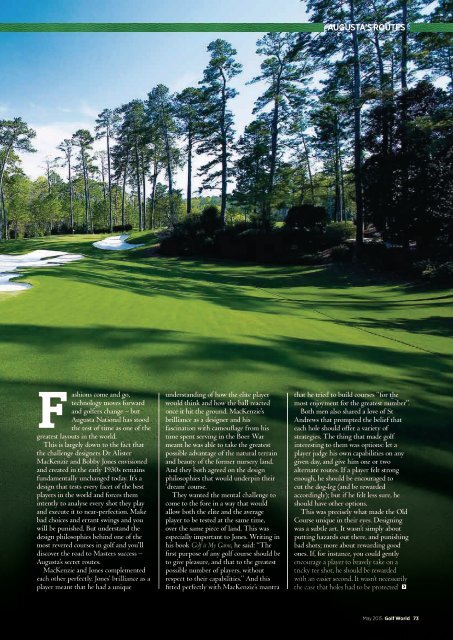Create successful ePaper yourself
Turn your PDF publications into a flip-book with our unique Google optimized e-Paper software.
augusta’s routes<br />
Fashions come and go,<br />
technology moves forward<br />
and golfers change – but<br />
Augusta National has stood<br />
the test of time as one of the<br />
greatest layouts in the world.<br />
This is largely down to the fact that<br />
the challenge designers Dr Alister<br />
MacKenzie and Bobby Jones envisioned<br />
and created in the early 1930s remains<br />
fundamentally unchanged today. It’s a<br />
design that tests every facet of the best<br />
players in the world and forces them<br />
intently to analyse every shot they play<br />
and execute it to near-perfection. Make<br />
bad choices and errant swings and you<br />
will be punished. But understand the<br />
design philosophies behind one of the<br />
most revered courses in golf and you’ll<br />
discover the road to Masters success –<br />
Augusta’s secret routes.<br />
MacKenzie and Jones complemented<br />
each other perfectly. Jones’ brilliance as a<br />
player meant that he had a unique<br />
understanding of how the elite player<br />
would think and how the ball reacted<br />
once it hit the ground. MacKenzie’s<br />
brilliance as a designer and his<br />
fascination with camouflage from his<br />
time spent serving in the Boer War<br />
meant he was able to take the greatest<br />
possible advantage of the natural terrain<br />
and beauty of the former nursery land.<br />
And they both agreed on the design<br />
philosophies that would underpin their<br />
‘dream’ course.<br />
They wanted the mental challenge to<br />
come to the fore in a way that would<br />
allow both the elite and the average<br />
player to be tested at the same time,<br />
over the same piece of land. This was<br />
especially important to Jones. Writing in<br />
his book <strong>Golf</strong> is My Game, he said: “The<br />
first purpose of any golf course should be<br />
to give pleasure, and that to the greatest<br />
possible number of players, without<br />
respect to their capabilities.” And this<br />
fitted perfectly with MacKenzie’s mantra<br />
that he tried to build courses “for the<br />
most enjoyment for the greatest number”.<br />
Both men also shared a love of St<br />
Andrews that prompted the belief that<br />
each hole should offer a variety of<br />
strategies. The thing that made golf<br />
interesting to them was options: let a<br />
player judge his own capabilities on any<br />
given day, and give him one or two<br />
alternate routes. If a player felt strong<br />
enough, he should be encouraged to<br />
cut the dog-leg (and be rewarded<br />
accordingly); but if he felt less sure, he<br />
should have other options.<br />
This was precisely what made the Old<br />
Course unique in their eyes. Designing<br />
was a subtle art. It wasn’t simply about<br />
putting hazards out there, and punishing<br />
bad shots; more about rewarding good<br />
ones. If, for instance, you could gently<br />
encourage a player to bravely take on a<br />
tricky tee shot, he should be rewarded<br />
with an easier second. It wasn’t necessarily<br />
the case that holes had to be protected<br />
<strong>May</strong> 2015 <strong>Golf</strong> <strong>World</strong> 73

















